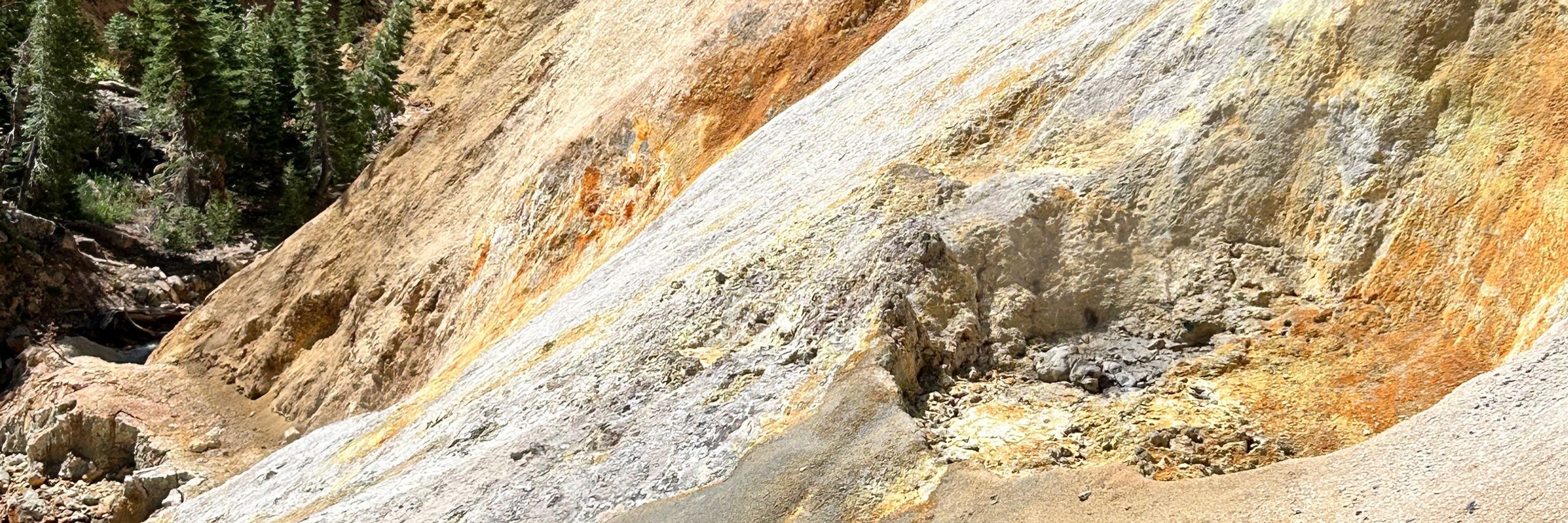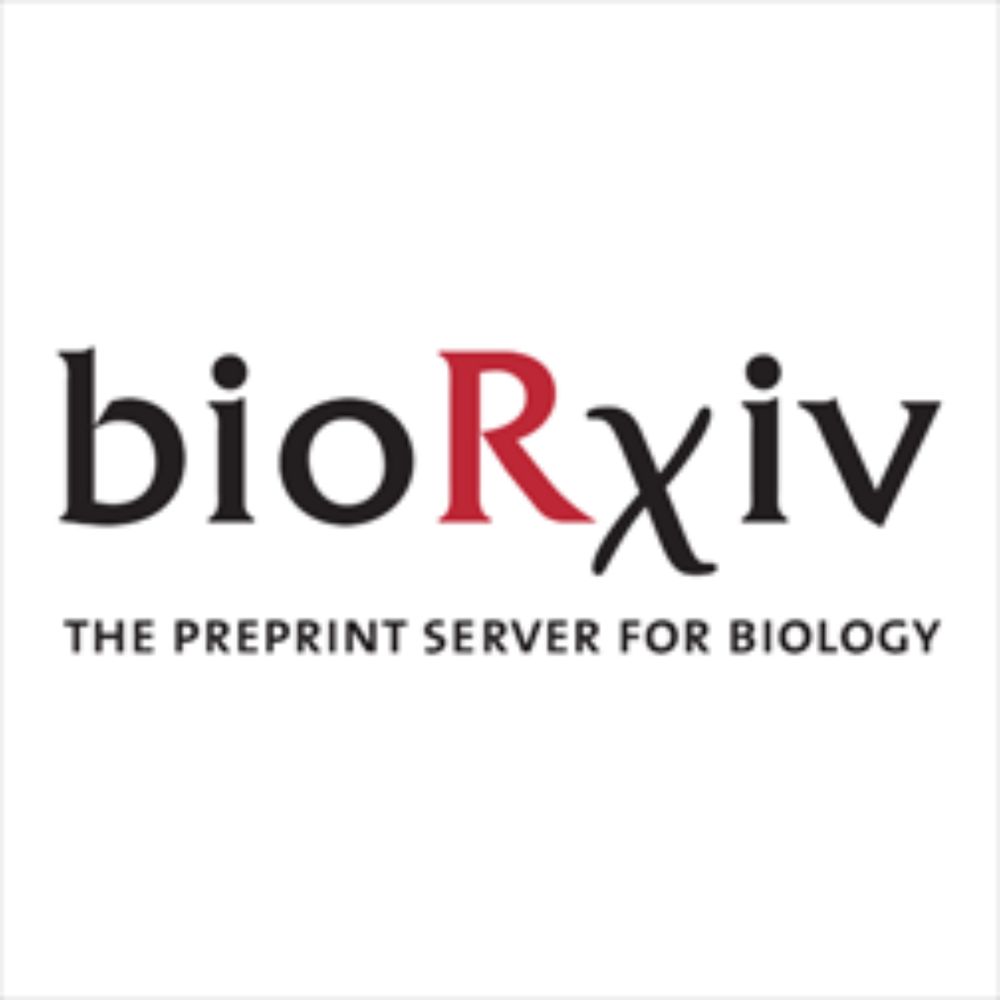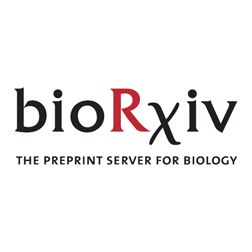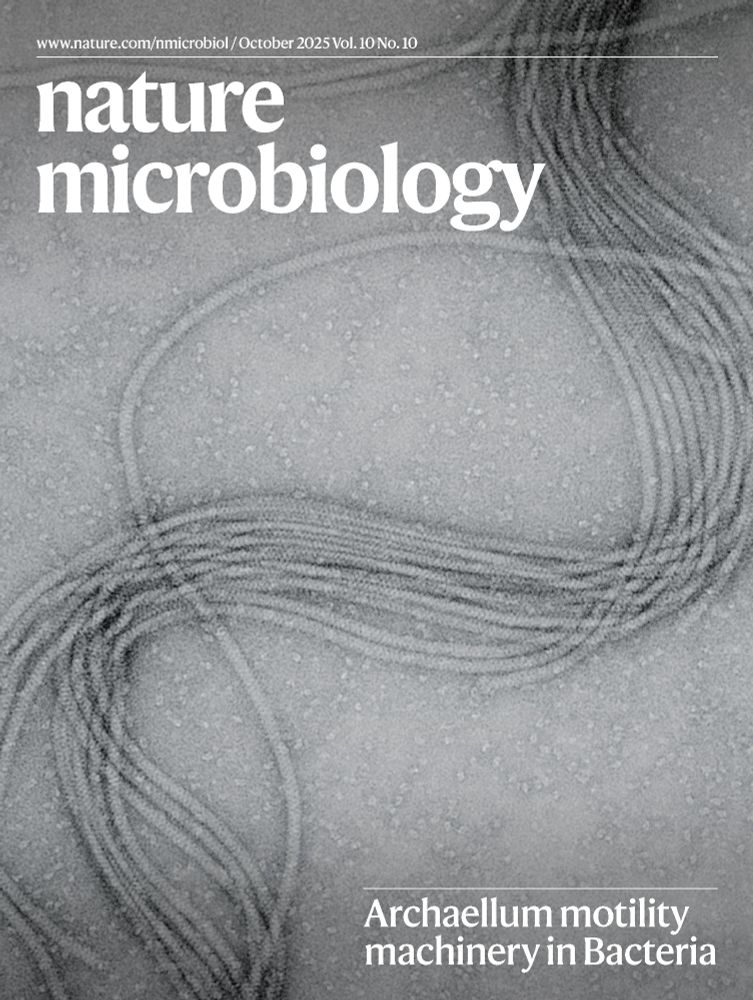
Sonja-Verena Albers
@archaellum.bsky.social
PI at the University of Freiburg, interested in molecular microbiology and all things related to #archaea
Pinned

Horizontal gene transfer of the functional archaellum machinery to Bacteria
Motility in Archaea is driven by a nanomachinery called the archaellum. So far, archaella have been exclusively described for the archaeal domain; however, a recent study reported the presence of arch...
www.biorxiv.org
Would you expect that Bacteria use an archaellum for swimming? We didn't, but we found that some Chloroflexota do! Find the story here: www.biorxiv.org/content/10.1...
A little thread below 1/n
A little thread below 1/n
Reposted by Sonja-Verena Albers
We have wondered what a complex archaeal cell might look like ever since 2014. It’s been a long road (and the journey is far from over), but it’s a good time to pause for breath and look. These Asgard archaeal cells are a surprise! And that is the joy of being a cell biologist.

November 7, 2025 at 11:02 AM
We have wondered what a complex archaeal cell might look like ever since 2014. It’s been a long road (and the journey is far from over), but it’s a good time to pause for breath and look. These Asgard archaeal cells are a surprise! And that is the joy of being a cell biologist.
Reposted by Sonja-Verena Albers
An Asgard archaeon containing internal membrane compartments!! 😯
This will reshape our understanding of how the eukaryotic endomembrane system originated.
Congrats to @buzzbaum.bsky.social, @tbharat-lab.bsky.social and all ppl involved!
www.biorxiv.org/content/10.1...
This will reshape our understanding of how the eukaryotic endomembrane system originated.
Congrats to @buzzbaum.bsky.social, @tbharat-lab.bsky.social and all ppl involved!
www.biorxiv.org/content/10.1...

An Asgard archaeon with internal membrane compartments
The emergence of eukaryotes from a merger between an archaeon and a bacterial cell ~two billion years ago involved a profound change in cellular organisation. While the order in which different featur...
www.biorxiv.org
November 8, 2025 at 5:15 PM
An Asgard archaeon containing internal membrane compartments!! 😯
This will reshape our understanding of how the eukaryotic endomembrane system originated.
Congrats to @buzzbaum.bsky.social, @tbharat-lab.bsky.social and all ppl involved!
www.biorxiv.org/content/10.1...
This will reshape our understanding of how the eukaryotic endomembrane system originated.
Congrats to @buzzbaum.bsky.social, @tbharat-lab.bsky.social and all ppl involved!
www.biorxiv.org/content/10.1...
Reposted by Sonja-Verena Albers
Genomic insights into antiviral defense systems in haloarchaea and their impact on virus susceptibility | bioRxiv https://www.biorxiv.org/content/10.1101/2025.11.08.687337v1?rss=1

Genomic insights into antiviral defense systems in haloarchaea and their impact on virus susceptibility
The ongoing evolutionary arm race between archaea and their viruses has led to the development of diverse defense systems against viruses. While recent computational approaches have uncovered many bacterial antiviral defense systems, the viral infection strategies and antiviral responses of archaea remain poorly explored. In this study, we identified antiviral defense systems encoded in the genomes of 20 recently sequenced haloarchaeal strains. These systems are representative of the broader repertoire of defense systems present across all 253 complete sequenced Halobacteria (class) genomes in the RefSeq database. Detailed analysis showed that these haloarchaea usually harbor multiple different defense systems, with a particularly high abundance of uncharacterized predicted defense systems against viruses (Phage Defense Candidates (PDCs)). To further explore the impact of anti-viral defense mechanisms on host range, an extensive virus-host pair screening was performed using a panel of known virulent viruses. By correlating the genomic defense profiles with observed viral infectivity and adsorption profiles, a weak correlation between the number of encoded defense systems and viral susceptibility was detected. Specifically, hosts infected by fewer viruses tended to encode a broader repertoire of antiviral defense systems, whereas those with fewer defense systems were frequently infected. It was found that the host range of haloarchaeal viruses is majorly determined by the availability of viral receptors, whereas the presence of anti-viral defense systems plays a smaller but significant role. These findings offer valuable insights into the evolutionary pressure shaping archaeal antiviral strategies and lay the groundwork for future functional studies of archaeal defense systems.
www.biorxiv.org
November 9, 2025 at 9:39 AM
Genomic insights into antiviral defense systems in haloarchaea and their impact on virus susceptibility | bioRxiv https://www.biorxiv.org/content/10.1101/2025.11.08.687337v1?rss=1
Reposted by Sonja-Verena Albers
📢 Interested in #chromosomes 🧬 & #archaea thriving at the edge of life? PhD project in York,UK on how archaea pass on their genome to daughter cells.Friendly supervisors: me, @steve-quinn-lab.bsky.social & @georgerheath.bsky.social
www.findaphd.com/phds/project...
📅 January 7, 2026
Please RP🙏thx!
www.findaphd.com/phds/project...
📅 January 7, 2026
Please RP🙏thx!


November 9, 2025 at 5:20 PM
📢 Interested in #chromosomes 🧬 & #archaea thriving at the edge of life? PhD project in York,UK on how archaea pass on their genome to daughter cells.Friendly supervisors: me, @steve-quinn-lab.bsky.social & @georgerheath.bsky.social
www.findaphd.com/phds/project...
📅 January 7, 2026
Please RP🙏thx!
www.findaphd.com/phds/project...
📅 January 7, 2026
Please RP🙏thx!
Reposted by Sonja-Verena Albers
Great collaboration with @guo-lab.bsky.social to determine an in situ architectural model of the Tad pilus machine. Be on the lookout soon for a preprint on the same topic by Grant Jensen and @viollierpat.bsky.social. #microsky

November 6, 2025 at 3:51 PM
Great collaboration with @guo-lab.bsky.social to determine an in situ architectural model of the Tad pilus machine. Be on the lookout soon for a preprint on the same topic by Grant Jensen and @viollierpat.bsky.social. #microsky
Reposted by Sonja-Verena Albers
📢 Postdoc position: Cell Biology of Cyanobacteria
in my group, as part of the Excellence Cluster "Microbes for Climate" (M4C) in Marburg, Germany.
More information at shorturl.at/wNnDT (see Project 2)
🔗Apply at shorturl.at/VsEDl
📅Deadline: Nov 16, 2025
Please repost. #Postdoc
in my group, as part of the Excellence Cluster "Microbes for Climate" (M4C) in Marburg, Germany.
More information at shorturl.at/wNnDT (see Project 2)
🔗Apply at shorturl.at/VsEDl
📅Deadline: Nov 16, 2025
Please repost. #Postdoc

November 2, 2025 at 7:13 PM
📢 Postdoc position: Cell Biology of Cyanobacteria
in my group, as part of the Excellence Cluster "Microbes for Climate" (M4C) in Marburg, Germany.
More information at shorturl.at/wNnDT (see Project 2)
🔗Apply at shorturl.at/VsEDl
📅Deadline: Nov 16, 2025
Please repost. #Postdoc
in my group, as part of the Excellence Cluster "Microbes for Climate" (M4C) in Marburg, Germany.
More information at shorturl.at/wNnDT (see Project 2)
🔗Apply at shorturl.at/VsEDl
📅Deadline: Nov 16, 2025
Please repost. #Postdoc
Reposted by Sonja-Verena Albers
(2/2) Expansion microscopy (ExM) allows scientists to easily and inexpensively visualise cellular structures that are challenging to see with traditional microscopy.
Learn more about how EMBL researchers are using ExM to push the boundaries of the life sciences: www.embl.org/news/science...
Learn more about how EMBL researchers are using ExM to push the boundaries of the life sciences: www.embl.org/news/science...

November 4, 2025 at 8:30 AM
(2/2) Expansion microscopy (ExM) allows scientists to easily and inexpensively visualise cellular structures that are challenging to see with traditional microscopy.
Learn more about how EMBL researchers are using ExM to push the boundaries of the life sciences: www.embl.org/news/science...
Learn more about how EMBL researchers are using ExM to push the boundaries of the life sciences: www.embl.org/news/science...
Reposted by Sonja-Verena Albers
We’re on the cover of @embojournal.org
Odin, from Norse mythology, emerges from the Odinarchaeota yellowstonii genome, holding FtsZ1 and FtsZ2 the ancestral twins of tubulin highlighting their evolutionary divergence in Asgard archaea. 👉 shorturl.at/n7iZE
#archaea #evolution #tubulin #cytoskeleton
Odin, from Norse mythology, emerges from the Odinarchaeota yellowstonii genome, holding FtsZ1 and FtsZ2 the ancestral twins of tubulin highlighting their evolutionary divergence in Asgard archaea. 👉 shorturl.at/n7iZE
#archaea #evolution #tubulin #cytoskeleton
November 3, 2025 at 11:54 AM
We’re on the cover of @embojournal.org
Odin, from Norse mythology, emerges from the Odinarchaeota yellowstonii genome, holding FtsZ1 and FtsZ2 the ancestral twins of tubulin highlighting their evolutionary divergence in Asgard archaea. 👉 shorturl.at/n7iZE
#archaea #evolution #tubulin #cytoskeleton
Odin, from Norse mythology, emerges from the Odinarchaeota yellowstonii genome, holding FtsZ1 and FtsZ2 the ancestral twins of tubulin highlighting their evolutionary divergence in Asgard archaea. 👉 shorturl.at/n7iZE
#archaea #evolution #tubulin #cytoskeleton
Reposted by Sonja-Verena Albers
This is going to be one of the biggest, most important features of AlphaFold @alphafold.bsky.social if further improved! Glycobiochemistry needs this bestfriend! #glycotime
academic.oup.com/glycob/artic...
academic.oup.com/glycob/artic...

Modeling glycans with AlphaFold 3: capabilities, caveats, and limitations
Abstract. Glycans are complex carbohydrates that exhibit extraordinary structural complexity and stereochemical diversity while playing essential roles in
academic.oup.com
October 31, 2025 at 8:51 PM
This is going to be one of the biggest, most important features of AlphaFold @alphafold.bsky.social if further improved! Glycobiochemistry needs this bestfriend! #glycotime
academic.oup.com/glycob/artic...
academic.oup.com/glycob/artic...
Reposted by Sonja-Verena Albers
Applications closing tonight (midnight French time) !!!
Still a few hours to apply !!
Still a few hours to apply !!
Open position to work on Type IX secretion (#T9SS) in our lab, in collaboration withe the group of Eric Reynolds at the Dental School of the University of Melbourne. Please spread the word, and forward to anyone potentially interested ! Apply here:
emploi.cnrs.fr/Offres/Docto...
emploi.cnrs.fr/Offres/Docto...
Portail Emploi CNRS - Offre d'emploi - Thèse en Microbiologie-Biochimie (H/F)
emploi.cnrs.fr
October 30, 2025 at 1:17 PM
Applications closing tonight (midnight French time) !!!
Still a few hours to apply !!
Still a few hours to apply !!
Reposted by Sonja-Verena Albers
Please RT. Post-doc opportunity alert! 💥 closing 10th December.. Come join our team (www.thelowlab.org) at Imperial, London, working on the structure and mechanism of bacterial secretion systems.
For more details and to apply please see
www.imperial.ac.uk/jobs/search-...
For more details and to apply please see
www.imperial.ac.uk/jobs/search-...

October 29, 2025 at 5:11 PM
Please RT. Post-doc opportunity alert! 💥 closing 10th December.. Come join our team (www.thelowlab.org) at Imperial, London, working on the structure and mechanism of bacterial secretion systems.
For more details and to apply please see
www.imperial.ac.uk/jobs/search-...
For more details and to apply please see
www.imperial.ac.uk/jobs/search-...
Reposted by Sonja-Verena Albers
Lab’s first paper is out!! We show the first structures of #Asgard #chromatin by #cryo-EM 🧬❄️
Asgard histones form closed and open hypernucleosomes. Closed are conserved across #Archaea, while open resemble eukaryotic H3–H4 octasomes and are Asgard-specific. More here: www.cell.com/molecular-ce...
Asgard histones form closed and open hypernucleosomes. Closed are conserved across #Archaea, while open resemble eukaryotic H3–H4 octasomes and are Asgard-specific. More here: www.cell.com/molecular-ce...

October 28, 2025 at 3:07 PM
Lab’s first paper is out!! We show the first structures of #Asgard #chromatin by #cryo-EM 🧬❄️
Asgard histones form closed and open hypernucleosomes. Closed are conserved across #Archaea, while open resemble eukaryotic H3–H4 octasomes and are Asgard-specific. More here: www.cell.com/molecular-ce...
Asgard histones form closed and open hypernucleosomes. Closed are conserved across #Archaea, while open resemble eukaryotic H3–H4 octasomes and are Asgard-specific. More here: www.cell.com/molecular-ce...
Reposted by Sonja-Verena Albers
How to become a "hot RNA" 🌡️? The answers were kindly provided by hyperthermophilic archaea: rRNA modifications are key! Check out this new publication presenting pan-modification profiling of the epitranscriptome. www.cell.com/cell/fulltex.... (1/3)

Pan-modification profiling facilitates a cross-evolutionary dissection of the thermoregulated ribosomal epitranscriptome
Pan-Mod-seq enables systematic, multi-modification mapping of rRNA across life. Applying
it to diverse organisms reveals that hyperthermophiles dynamically install stabilizing
modifications to support...
www.cell.com
October 27, 2025 at 1:19 PM
How to become a "hot RNA" 🌡️? The answers were kindly provided by hyperthermophilic archaea: rRNA modifications are key! Check out this new publication presenting pan-modification profiling of the epitranscriptome. www.cell.com/cell/fulltex.... (1/3)
Reposted by Sonja-Verena Albers
Archaea alert 🚨! This WEDNESDAY, Oct. 22nd at 10 AM EST / 4PM CET, we will kick off our fall seminar series with a talk from Dr. Nili Ostrov, co-founder of Cultivarium FRO, telling us about her organization’s work to accelerate genetics in non-model organisms including archaea!! Zoom link in email!

October 20, 2025 at 4:30 PM
Archaea alert 🚨! This WEDNESDAY, Oct. 22nd at 10 AM EST / 4PM CET, we will kick off our fall seminar series with a talk from Dr. Nili Ostrov, co-founder of Cultivarium FRO, telling us about her organization’s work to accelerate genetics in non-model organisms including archaea!! Zoom link in email!
Reposted by Sonja-Verena Albers
Second up this WEDNESDAY at 10AM EST / 4 PM CET, we have an exciting talk from Dr. Yan Liao who will tell us about her research combing molecular genetics and advanced microscopy techniques to shed light on archaeal cell division!! Check your email or sign up for the link: forms.gle/6QvCjHH2H4pxro…

October 20, 2025 at 4:37 PM
Second up this WEDNESDAY at 10AM EST / 4 PM CET, we have an exciting talk from Dr. Yan Liao who will tell us about her research combing molecular genetics and advanced microscopy techniques to shed light on archaeal cell division!! Check your email or sign up for the link: forms.gle/6QvCjHH2H4pxro…
Reposted by Sonja-Verena Albers
We’re excited to announce the incredible speaker line-up for the Prokaryotic Cell Biology Conference! Join the leading researchers as they explore the latest advances in Nanoimaging, Cell Growth and Cellular Structures.
Join our speakers & register today! ➡️https://bit.ly/47rtkbw
#ProkaryoticCellBio
Join our speakers & register today! ➡️https://bit.ly/47rtkbw
#ProkaryoticCellBio

October 16, 2025 at 2:27 PM
We’re excited to announce the incredible speaker line-up for the Prokaryotic Cell Biology Conference! Join the leading researchers as they explore the latest advances in Nanoimaging, Cell Growth and Cellular Structures.
Join our speakers & register today! ➡️https://bit.ly/47rtkbw
#ProkaryoticCellBio
Join our speakers & register today! ➡️https://bit.ly/47rtkbw
#ProkaryoticCellBio
Reposted by Sonja-Verena Albers
Everyone interested in bacterial signal transduction, environmental sensing and motility, don't miss this conference organised by Ariane Briegel @arianebriegel.bsky.social and myself! We have great invited speakers and a number of slots allocated to short talks: www.grc.org/sensory-tran...
2026 Sensory Transduction in Microorganisms Conference GRC
The 2026 Gordon Research Conference on Sensory Transduction in Microorganisms will be held in Ventura, California. Apply today to reserve your spot.
www.grc.org
October 15, 2025 at 6:06 PM
Everyone interested in bacterial signal transduction, environmental sensing and motility, don't miss this conference organised by Ariane Briegel @arianebriegel.bsky.social and myself! We have great invited speakers and a number of slots allocated to short talks: www.grc.org/sensory-tran...
Reposted by Sonja-Verena Albers
Balancing stability and flexibility when reshaping archaeal membranes.
buff.ly/4yqUdBj
buff.ly/4yqUdBj
October 10, 2025 at 8:03 PM
Balancing stability and flexibility when reshaping archaeal membranes.
buff.ly/4yqUdBj
buff.ly/4yqUdBj
Reposted by Sonja-Verena Albers
A new family of ribosome hibernation factors in Archaea | bioRxiv https://www.biorxiv.org/content/10.1101/2025.10.11.676729v1?rss=1

A new family of ribosome hibernation factors in Archaea
Ribosome hibernation preserves translation machinery during stress, yet its mechanisms in Archaea remain poorly defined. Here we identify Hib, a previously unrecognized family of archaeal hibernation factors. Genetic, structural and biochemical analyses show that Hib binds ribosomal subunits, blocking the mRNA channel and tRNA sites to inactivate translation. Deletion of hib in Thermococcus barophilus delays recovery from stationary phase and reduces 70S ribosome pools, establishing its role in ribosome preservation. Hib displays a unique modular architecture, combining a bacterial-like HPF module with tandem CBS domains. Cryo-EM structures reveal conformational heterogeneity of Hib:ribosome complexes, consistent with dynamic engagement, and the CBS-containing N-terminal domain binds adenine nucleotides, suggesting a link between hibernation and energy status. These findings define Hib as a key archaeal hibernation factor and provide a framework for understanding ribosome dormancy and adaptation across all domains of life. ### Competing Interest Statement The authors have declared no competing interest. Agence Nationale de la Recherche, https://ror.org/00rbzpz17, ANR-25-CE12-4161
www.biorxiv.org
October 12, 2025 at 4:57 AM
A new family of ribosome hibernation factors in Archaea | bioRxiv https://www.biorxiv.org/content/10.1101/2025.10.11.676729v1?rss=1
Reposted by Sonja-Verena Albers
Open position to work on Type IX secretion (#T9SS) in our lab, in collaboration withe the group of Eric Reynolds at the Dental School of the University of Melbourne. Please spread the word, and forward to anyone potentially interested ! Apply here:
emploi.cnrs.fr/Offres/Docto...
emploi.cnrs.fr/Offres/Docto...
Portail Emploi CNRS - Offre d'emploi - Thèse en Microbiologie-Biochimie (H/F)
emploi.cnrs.fr
October 9, 2025 at 12:18 PM
Open position to work on Type IX secretion (#T9SS) in our lab, in collaboration withe the group of Eric Reynolds at the Dental School of the University of Melbourne. Please spread the word, and forward to anyone potentially interested ! Apply here:
emploi.cnrs.fr/Offres/Docto...
emploi.cnrs.fr/Offres/Docto...
Reposted by Sonja-Verena Albers
Out in Science Advances: Our #cryoEM structure of HFTV1, a virus infecting the halophile #archaea. *First full atomic structure (containing all structural proteins) of any tailed virus!* Congrats and thanks to all co-authors and our fantastic collaborators! www.science.org/doi/10.1126/...

Cryo-EM resolves the structure of the archaeal dsDNA virus HFTV1 from head to tail
This structure of an archaeal tailed virus (arTV) provides detailed insights into arTV assembly and infection mechanisms.
www.science.org
October 6, 2025 at 11:31 AM
Out in Science Advances: Our #cryoEM structure of HFTV1, a virus infecting the halophile #archaea. *First full atomic structure (containing all structural proteins) of any tailed virus!* Congrats and thanks to all co-authors and our fantastic collaborators! www.science.org/doi/10.1126/...
Look at this nice cover: beautiful archaella, image made by @sshamphavi.bsky.social !
Thanks also to Marta Rodeiguez for keeping the EM im shape in @ottlab.bsky.social lab!
At @biologyunifreiburg.bsky.social at @uni-freiburg.de @sfb1381.bsky.social @cibss.bsky.social
Thanks also to Marta Rodeiguez for keeping the EM im shape in @ottlab.bsky.social lab!
At @biologyunifreiburg.bsky.social at @uni-freiburg.de @sfb1381.bsky.social @cibss.bsky.social
Some keen Observations in Our October issue!
🦠 Cancer microbiome
🌊 Marine microbes in warming oceans
🌐 broad-range phages
🧬 genetically minimised Salmonella
🔧 Viral infection mechanisms
🧪 Oxaloacetate antiviral defence
and more, here: www.nature.com/nmicrobiol/v...
🦠 Cancer microbiome
🌊 Marine microbes in warming oceans
🌐 broad-range phages
🧬 genetically minimised Salmonella
🔧 Viral infection mechanisms
🧪 Oxaloacetate antiviral defence
and more, here: www.nature.com/nmicrobiol/v...

October 2, 2025 at 8:28 AM
Look at this nice cover: beautiful archaella, image made by @sshamphavi.bsky.social !
Thanks also to Marta Rodeiguez for keeping the EM im shape in @ottlab.bsky.social lab!
At @biologyunifreiburg.bsky.social at @uni-freiburg.de @sfb1381.bsky.social @cibss.bsky.social
Thanks also to Marta Rodeiguez for keeping the EM im shape in @ottlab.bsky.social lab!
At @biologyunifreiburg.bsky.social at @uni-freiburg.de @sfb1381.bsky.social @cibss.bsky.social
Reposted by Sonja-Verena Albers
Some keen Observations in Our October issue!
🦠 Cancer microbiome
🌊 Marine microbes in warming oceans
🌐 broad-range phages
🧬 genetically minimised Salmonella
🔧 Viral infection mechanisms
🧪 Oxaloacetate antiviral defence
and more, here: www.nature.com/nmicrobiol/v...
🦠 Cancer microbiome
🌊 Marine microbes in warming oceans
🌐 broad-range phages
🧬 genetically minimised Salmonella
🔧 Viral infection mechanisms
🧪 Oxaloacetate antiviral defence
and more, here: www.nature.com/nmicrobiol/v...

October 1, 2025 at 5:30 PM
Some keen Observations in Our October issue!
🦠 Cancer microbiome
🌊 Marine microbes in warming oceans
🌐 broad-range phages
🧬 genetically minimised Salmonella
🔧 Viral infection mechanisms
🧪 Oxaloacetate antiviral defence
and more, here: www.nature.com/nmicrobiol/v...
🦠 Cancer microbiome
🌊 Marine microbes in warming oceans
🌐 broad-range phages
🧬 genetically minimised Salmonella
🔧 Viral infection mechanisms
🧪 Oxaloacetate antiviral defence
and more, here: www.nature.com/nmicrobiol/v...
Reposted by Sonja-Verena Albers
The future of @cibss.bsky.social @uni-freiburg.de is about teamwork, curiosity, and collaboration across disciplines.
We are thrilled to be in this together @kraftlabfr.bsky.social @archaellum.bsky.social @kleinevehnlab.bsky.social !
We are thrilled to be in this together @kraftlabfr.bsky.social @archaellum.bsky.social @kleinevehnlab.bsky.social !

September 22, 2025 at 2:40 PM
The future of @cibss.bsky.social @uni-freiburg.de is about teamwork, curiosity, and collaboration across disciplines.
We are thrilled to be in this together @kraftlabfr.bsky.social @archaellum.bsky.social @kleinevehnlab.bsky.social !
We are thrilled to be in this together @kraftlabfr.bsky.social @archaellum.bsky.social @kleinevehnlab.bsky.social !
Reposted by Sonja-Verena Albers
Early-career researchers: want to run your own lab? 🌟Max Planck Research Groups offer 6+ years, up to €2.7M in funding, open-topic freedom, team support & tenure-track opportunities. Intrigued? 😃Apply by Oct 14, 2025! www.mpg.de/max-planck-r...

September 15, 2025 at 9:27 AM
Early-career researchers: want to run your own lab? 🌟Max Planck Research Groups offer 6+ years, up to €2.7M in funding, open-topic freedom, team support & tenure-track opportunities. Intrigued? 😃Apply by Oct 14, 2025! www.mpg.de/max-planck-r...

